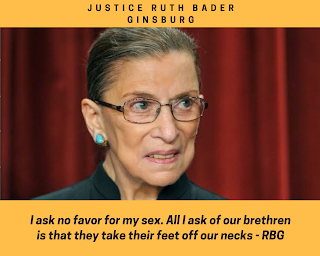In 1956, 23-year old Ruth Bader Ginsburg,
fondly called ‘Notorious RBG’, got her admission in Harvard Law School. She was
one among the nine woman - in a class strength of 500. Her dean invited all nine
women law students home for dinner, and asked each one of them what they were
doing taking the place of a man. The fact that this could happen in the country
with the oldest written Constitution of the world, and in one of the world’s
most prestigious law schools, reflects how deeply embedded gender bias has
always been.
Around 4 years later, just as RBG finished
law school with good grades, another Dean at Harvard recommended her for a
clerkship with Justice Felix Frankfurter of the US Supreme Court. Justice
Frankfurter refused to hire her, stating that although her candidature was
impressive, he was still ‘not ready’ to hire a woman. RBG could also not find a
job in any law firm in New York, as all of them refused to hire a woman. But,
none of this deterred her, and only strengthened her resolve to fight against
gender-based discrimination.
From 1963-1972, RBG spent the early years
of her career as a Professor in Rutgers Law School, where she taught courses on
civil procedure and ‘gender and law’. In 1971, RBG wrote her first brief for
the US Supreme Court in Reed v. Reed.
In Reed v. Reed, the issue was whether a State could directly prefer men
over women as executors of family property. The US Supreme Court answered in
the negative, and struck down the State law on the ground that it violated the
equal protection clause, present in the 14th Amendment
of the US Constitution. This was the first time that the US Supreme Court had
struck down a State law for being gender discriminatory.
RBG firmly believed that the equal
protection clause should invalidate any law that was gender discriminatory. While
this interpretation may seem obvious today, RBG says that she had faced a tough
challenge in convincing the Court - as many judges did not even believe that
there was something known as gender-based discrimination! She had to tap into
the emotions of the judge, and would ask them about the kind of world they wanted
to leave behind for their daughters and granddaughters.
She argued her first case before the US Supreme Court in 1973, where she represented Sharron Frontiero - an Air Force employee who had been denied housing allowance because she was a woman. RBG was among the first to convince the Court that along with affecting woman, gender discrimination of any kind also affects society at large. This was a point she stressed on while representing Steven Wiesenfield, who was denied social security benefits after losing his wife as soon as she gave birth to their child.
Steven was denied social security benefits on the ground that only widows were eligible to receive it, and not widowers like him. Before the Supreme Court, RBG argued that denying social security payments to a man was based on the stereotype that only women can be homemakers - for taking care of their children. This case epitomized her approach, where she focused on gender discrimination from a perspective of social consequences, and not solely as a man-woman binary.
After her stellar work for gender
justice, she was nominated as a Federal Judge in the Columbia Circuit, where
she served for 13 years before being nominated to the US Supreme Court in 1993,
at the ripe age of 60. RBG was just 1 out of almost 30 candidates who were shortlisted
for elevation. But, when she was called to the White House for an interview
with President Bill Clinton, it took her just 15 minutes to convince him about
what she could bring to the table – as the 2nd woman to be appointed
to the Supreme Court.
In her 27 years in the Supreme Court, RBG’s
judgments reflected the changes that she wanted, and had always fought for. She
struck down the
admission policy of the Virginia Military Institute, which forbade women from
applying for admission even if they were capable of satisfying the admission
criteria. Although inducting women faced resistance at multiple levels, RBG stuck
to her view of the equal protection clause, stating that if women were given
equal opportunity, even they can do us proud.
RBG also penned a number of landmark
dissents, where she hoped that her views would “appeal to the intelligence
of a future day”. She dissented from the majority view in the Ledbetter case
- where the majority refused to honour Lilly Ledbetter’s right to receive equal
pay in comparison to her male counterparts. While upholding Ledbetter’s right
to receive equal way, she called out the majority judges’ indifference towards
the different ways in which gender-based wage discrimination can take place.
She concluded her dissent by stating
that now, “the ball is in Congress’ Court”. This definitely appealed to the
intelligence of a future day, as two years later, the US Congress passed the
Lilly Ledbetter Fair Pay Act, 2009.
During her tenure in the Supreme Court, RBG also developed a close friendship with Justice Scalia, even though he was a conservative, and disagreed with her at an ideological level. Their opposite ideological viewpoints and disagreements on the Bench did not affect their personal equations. In fact, Justice Scalia had once jokingly remarked that the only thing he didn’t like about RBG was her reading of the law! Their friendship is a lesson for everyone in these polarized times, where we tend to hamper our personal equations with those who disagree with us ideologically.
From being denied clerkships and law firm jobs on account of her gender, RBG charted her own journey - by providing a new name to gender justice. Her vision of creating a better world for our daughters and granddaughters must be cherished, preserved and fought for. RIP.




No comments:
Post a Comment